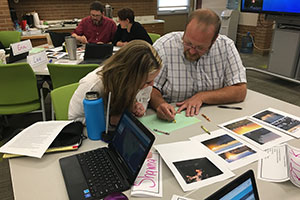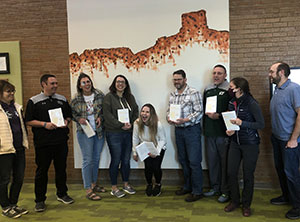UW, Green River Educators Collaborate to Transform Science Instruction
Published April 29, 2022

A multiyear collaboration between high school science teachers in Green River and the University of Wyoming’s Science and Math Teaching Center (SMTC) has transformed the educational experience for hundreds of students in that southwest Wyoming community.
The collaboration is detailed in an article in the journal Schools: Studies in Education, published by the University of Chicago Press.
SMTC faculty and staff members Martha Inouye, Ana Houseal and Clare Gunshenan provided professional development training on Next Generation Science Standards (NGSS) and Wyoming standards to science teachers Megan Allen, Erin Arnold, Katie Camis, Rick Carroll, Matt Freze, Lee Harper, Shawna Mattson and Dan Parson, from Green River and Expedition Academy high schools.
NGSS is a science education reform effort that emerged from decades of research on effective science teaching and learning. The reform seeks to make science more accessible, equitable and meaningful to K-12 students. Largely, this is done by providing students with opportunities to learn science by doing science in ways that parallel professional scientists. UW educators played a key role in Wyoming’s 2016 adoption and subsequent implementation of the new science standards.
“We have developed a completely new understanding of teaching science, and we are striving every day to meet the goals of NGSS,” the teachers wrote in the journal article. “Our roles as teachers have shifted from the giver to the facilitator, and the burden of learning has shifted to our students. We were forever changed by the unexpected.”
Inouye, Houseal and Gunshenan conducted a series of workshops with the Green River teachers and administrators over five years, which included model lessons using NGSS-aligned instruction and exploring current research on science teaching and learning. As they were implementing the new strategies to support more student-driven learning, the teachers observed one another in the classroom, building a strong culture of growing and learning together.
“This change (in our instruction) has allowed students to learn by doing, and it has deepened their conceptual understanding, as evidenced by their assessment scores,” says Freze, who teaches physical science, physics and astronomy in Green River.

“This professional development helped me to see that true student engagement means that the students are answering the questions, enlightening one another and working together to come to a greater understanding of the concepts they actually present to one another,” says Carroll, who has taught for 39 years.
The teachers say the experience not only changed the way they teach science, but also how they relate to one another.
“In addition to examining our teaching practices, the relationships my colleagues and I have formed through this process have led to a deep bond built on trust and support. This bond was fostered by our willingness to be vulnerable around each other, encouraged and pushed by facilitators,” says Mattson, who has taught high school biology and environmental science for five years. “We have developed a healthy culture of authentic collaboration, in which we share ideas and practices. New ideas have flourished that otherwise would have remained hidden.”
“This journey has become more than just a shift for my students,” says Parson, a 30-year teacher. “This experience has sparked a creativity and sharing of instructional practice that, as a teacher, I have not experienced before.”
The SMTC facilitators agree with the teachers’ reflections about their journey toward embracing new ways of teaching science.
“These teachers should be applauded for their efforts and willingness to critically evaluate their teaching practices and take the time and energy to make adjustments. They have spent hundreds of hours thinking deeply about their instruction, their students’ needs and how they can push one another to be more effective educators,” says Inouye, who was instrumental in securing this multiyear collaboration, facilitated their workshops and supported them in writing the article. “The collaborative community they have built with one another is a model worth sharing.”
In its 52-year history, UW’s SMTC has worked with thousands of teachers across all Wyoming school districts. Since 2015, the SMTC professional development team has contracted with 14 school districts for sustained science professional development. The professional development team also has supported teachers from 24 Wyoming school districts in open-enrollment workshops, allowing participants to collaborate with colleagues around the state.
The SMTC further supports Wyoming’s teachers with long-standing graduate programs and endorsements in middle-level science and math teaching. The SMTC’s programs and professional development continue to help many teachers make strides in their teaching and learning, with major benefits for Wyoming students.

